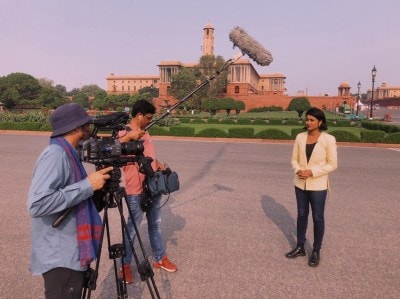- India
- International
15 days after Cyclone Tauktae passed, people of Amreli’s lion country stumble through life without power
The cyclone left 10,447 villages in the state without power, with 23,800 km of transmission lines, 1.16 lakh electricity poles, and 45,039 transformers damaged.
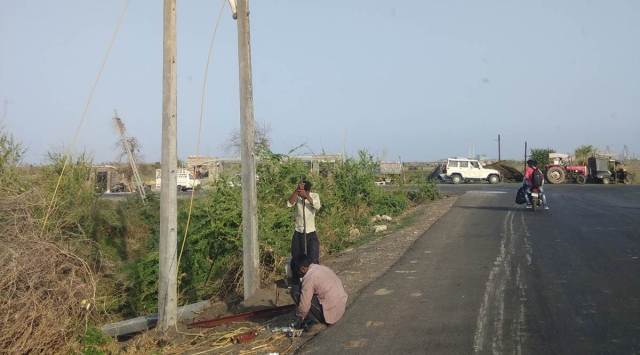 Tauktae damaged electricity lines and poles. (Express photo by Gopal Kateshiya)
Tauktae damaged electricity lines and poles. (Express photo by Gopal Kateshiya)Pavan Khuman, a farmer of Mota Agariya village in Rajula taluka, has sent his sons Rajvir, 17 and Vijay, 14, to his niece’s home in Dhari. Since Cyclone Tauktae reduced their home to rubble and snapped the power lines, the family has been spending nights outdoors, in the dark, in fear of lions on the prowl nearby.
Amreli is one of the four Gujarat districts across which Gir, the home of the Asiatic lion, spans. The darkness has emboldened the lions and leopards, says Khuman. “Lions roar outside the damaged wall of my house. My family, my five cows, my bullocks, we live in terror.”
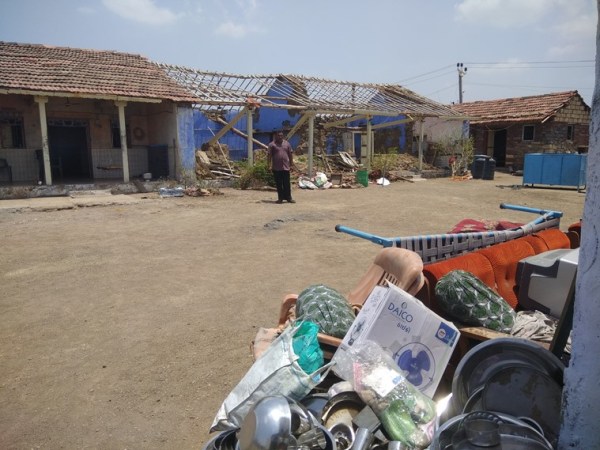 Pavan Khuman at his damaged home in Mota Agariya village in Rajula taluka, in Amreli on Monday. (Express Photo by Gopal Kateshiya)
Pavan Khuman at his damaged home in Mota Agariya village in Rajula taluka, in Amreli on Monday. (Express Photo by Gopal Kateshiya)
A fortnight after the cyclone struck on May 17, 191 of 619 villages of Amreli district are still without power, as per a release by Paschim Gujarat Vij Company Limited (PGVCL), the state-owned company that distributes electricity in Saurashtra region.
The cyclone left 10,447 villages in the state without power, with 23,800 km of transmission lines, 1.16 lakh electricity poles, and 45,039 transformers damaged.
Says Mota Agariya village sarpanch Hathi Khuman, “Lions avoid illuminated areas. But our streetlights have been out since Tauktae.” With piped water supply also hit due to lack of power, he and his brother have been using a diesel-fired generator to provide drinking water to the village.

The lack of electricity has also forced other changes. Kanchan Savaliya, 60, says it is after many years that she is using a ravaiya (a wooden churner) regularly to skim milk. “We have an electric skimmer… I had to search the house to locate this one.”
The family’s home and cattle shed were damaged in the cyclone. Kanchan’s brother-in-law Ramesh says one of the first adjustments they had to make was figuring out how to ensure milk didn’t spoil without a refrigerator. “Eventually, my mother turned to the old way, of keeping the milk container in water.”
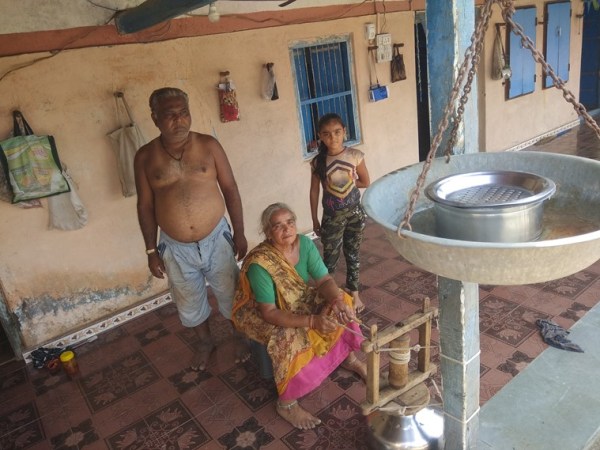 Kanchan Savaliya skims milk as Ramesh and her granddaughter Reminds look on, in Mota Agariya village in Rajula taluka, in Amreli. (Express Photo by Gopal Kateshiya)
Kanchan Savaliya skims milk as Ramesh and her granddaughter Reminds look on, in Mota Agariya village in Rajula taluka, in Amreli. (Express Photo by Gopal Kateshiya)
In neighbouring Vavdi village, Mukta Sarola, 45, uses a charpoy as shade against the sun as she cleans some dented kitchen pots. These are among the only things the family of daily agricultural labourers managed to salvage from the rubble of their home, the rest of the belongings bundled up in bedsheets.
“I run to the road with the pots when we hear a water tanker has come. I also fetch water from a nearby stone quarry that is currently filled with rainwater,” says Sarola. A few houses in the village have piped water connections, apart from a common hand pump.
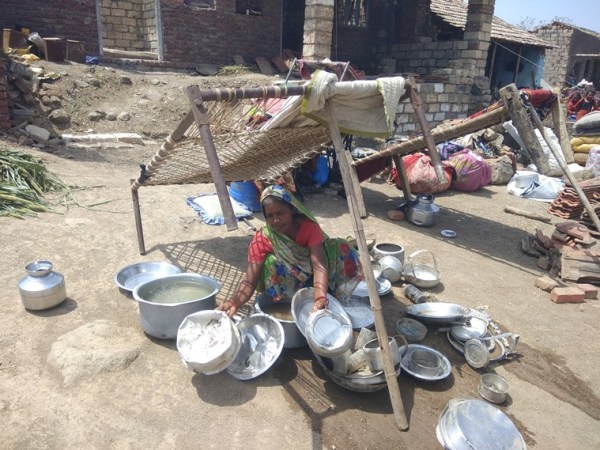 Mukta Sarola washes utensils salvaged from her damaged home in Bvavadi village of Rajula taluka, in Amreli on Monday. (Express Photo by Gopal Kateshiya)
Mukta Sarola washes utensils salvaged from her damaged home in Bvavadi village of Rajula taluka, in Amreli on Monday. (Express Photo by Gopal Kateshiya)In Hindorna village of Rajula taluka, women use bowls to scoop water out of holes dug in the bed of Dhatarvadi river and fill their pots — a practice that dates back generations.
 Girls draw water from a sandpit in the bed of Dhatarvadi River in Hindorna Village on the outskirts of Rajula town, in Amreli. (Express Photo by Gopal Kateshiya)
Girls draw water from a sandpit in the bed of Dhatarvadi River in Hindorna Village on the outskirts of Rajula town, in Amreli. (Express Photo by Gopal Kateshiya)Amreli District Collector Ayush Oak said, “Some villages have water distribution issues but as on today (Monday), 99 tankers are making 374 trips to supply water to affected villages.”
Bachu Sankhat, 65, who runs a general store in Mitiyala village, 5 km from Jafrabad town (where the cyclone made landfall), says he has never seen this long power outage in three decades.
Even urban areas are hit. Sanjya Dafda, who lives in Jafrabad town and runs an Ayurveda clinic in Mitiyala, worries for his children. “Our daughters, 9 and 2, are forced to sleep on the terrace.”
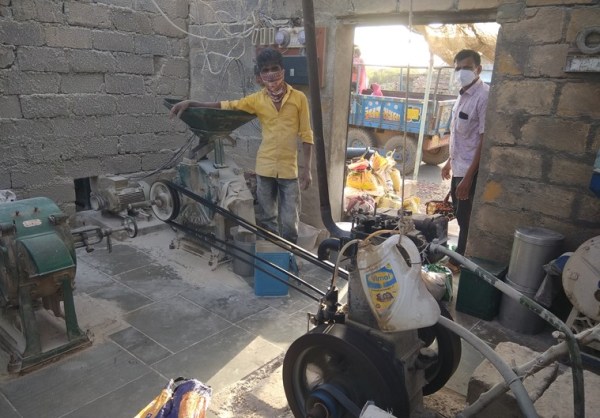 Sanjay Dafda has a flour mill set at his home in Jafrabad but as there is no power, he had to grind his grain at a diesel engine flour mill in Mitiyala village. (Express Photo by Gopal Kateshiya)
Sanjay Dafda has a flour mill set at his home in Jafrabad but as there is no power, he had to grind his grain at a diesel engine flour mill in Mitiyala village. (Express Photo by Gopal Kateshiya)As the sun slips under the horizon, Dahiben stands wiping her tears on the Jafrabad harbour bridge. As her son-in-law Manji Vansh tugs at the remains of his fishing trawler with the help of a tractor, Dahiben cries, “Kain nikalyu nahi, bhai, kain nikalyu nahi! (Nothing is there to salvage, nothing)!”
Eventually, the tugging rope snaps, and Vansh gives up his bid to salvage the trawler. It is the fifth day this has happened. Vansh had thought his woes had ended when he had found the trawler after five days of search following the cyclone.
“We had paid Rs 10 lakh to lease the boat this year, hoping to pay back from our earnings. But now our fishing gear and equipment worth lakhs has been washed away,” says Rahul, Vansh’s 19-year-old son, who dropped out of school and works with his father.
Vansh worries that there is no word from the government yet on compensation. “A team from the Fisheries Department surveyed our boat. But we haven’t heard anything.”
Local fishermen leaders say more than 200 boats were damaged during the cyclone. “The government has called us to Gandhinagar for a meeting. We are hopeful of a relief package,” says Kanaiyalal Solanki, president of the Kharva Samaj Machhimar Boat Association of Jafrabad.
Shahmeena Husain, managing director of Gujarat Urja Vikas Nigam Limited, that has six subsidiary companies, including PGVCL, says while power has been restored in almost all urban areas, a large number of villages remain without electricity. “These are the difficult villages, with rocky terrains, where the entire network has been damaged. One team is able to rectify six-seven electricity poles a day here, compared to 10-12 elsewhere,” she says.
Out of 230 sub-stations damaged, now five that supply power to 154 villages are left to be restored. “We hope to finish the work in Amreli within a day or two. For Una (in Gir Somnath district), it will take three days more,” Husain says. —With inputs from AVINASH NAIR in Ahmedabad
Must Read
Apr 23: Latest News
- 01
- 02
- 03
- 04
- 05











